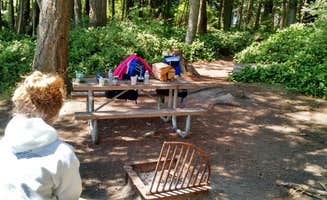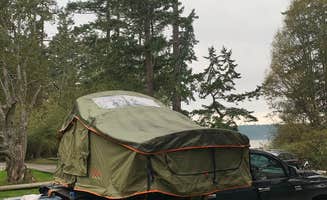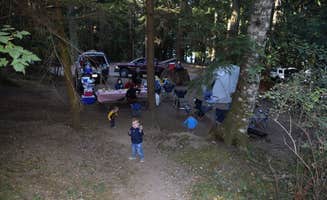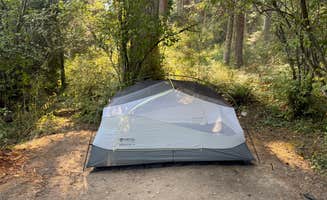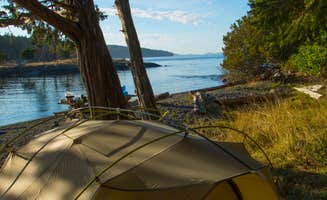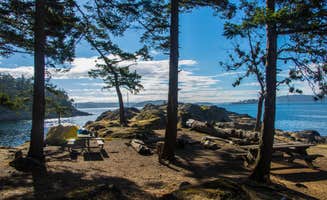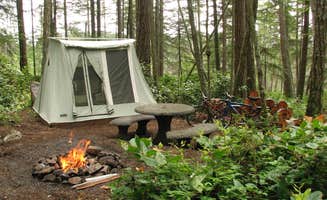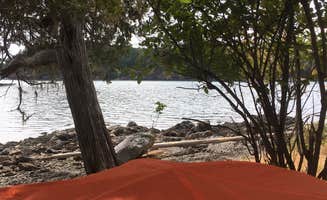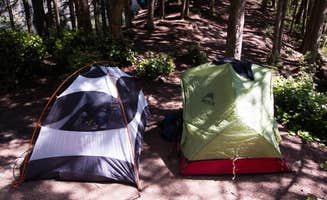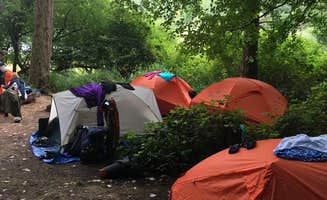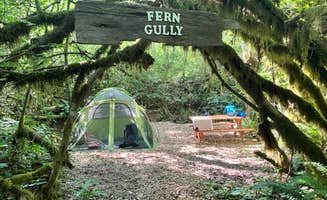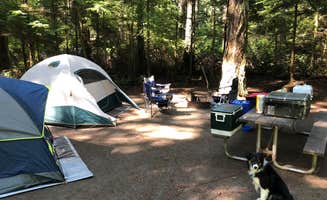Tent campsites near Blakely Island, Washington include several state and county parks across the San Juan Islands. The parks range from 1 to 25 miles from Blakely Island and sit at sea level, with most experiencing a marine climate of mild winters and cool summers. Annual rainfall averages 25-30 inches with prevailing northwest winds that can affect camping conditions, especially for kayakers and small boat users.
What to do
Hike to viewpoints: At Moran State Park on Orcas Island, follow hiking trails leading to Mt. Constitution. "Miles of hiking trails that lead to the highest point in the San Juans, Mt Constitution. One of the most incredible views I have ever seen in the PNW," notes Hilary S. The lookout tower resembles a castle with panoramic island views.
Kayak and swim: Mountain Lake Campground offers excellent lake activities. "It sits on Lake Moran which is a fun lake to kayak and cliff jump," shares Rich M. The 3-mile trail around the lake includes "a fun bridge to jump off of to swim," according to Jessica B.
Beach exploration: Turn Island State Park provides excellent shoreline access for wildlife viewing. Located just outside Friday Harbor, the island offers "great beach sites" and is "great for sunset or sunrise," according to Shari G. The small island has a short trail circling its perimeter.
Wildlife viewing: For marine wildlife encounters, paddle to the outer islands. At Sucia Island, visitors report excellent opportunities. "Cool rock scrambling in the sandstone cliffs, great tide pooling, and great people," says Kaila R. The island is large enough that "it can take a few days to explore the whole thing."
What campers like
Privacy in proximity: Obstruction Pass State Park sites balance seclusion with convenience. "The campsite is walk-to, about a 1/2 mile, making it a backpacking kind of overnight for kids or friends who don't want to be too far from a car and civilization," says Kim B. The park offers a good introduction to remote camping without difficult access.
Protection from elements: Many San Juan tent sites are strategically positioned for comfort in changing conditions. As Don notes about Obstruction Pass, "My twelve year old wanted to try backpacking, but not hike too far. My wife didn't want us to get eaten by bears. The solution? Obstruction Pass!" The moderate terrain makes it accessible for beginners.
Waterfront access: Odlin County Park on Lopez Island provides prime beach camping. "There are plenty of beach sites, a few are 'walk-in' – which just means that you can't park your car there," explains Shari G. Neil T. appreciated the diversity: "Great bay with beach sites and tree lined sites. Quiet, beautiful, peaceful."
Island solitude: Smaller islands offer escape from crowds. At Clark Island, Jill R. found solitude even in summer: "On September 18, I was the only person there and enjoyed an evening of humpback whales blowing in the channel to the east of me."
What you should know
Wildlife management: San Juan Island tent campsites require careful food storage. At Turn Island, "the raccoons as cute as they are will walk up to your campsite right in front of you and steal your food. I repeat RIGHT IN FRONT OF YOU and will stare you down if you try to scare them away," warns Kayko S.
Sanitation varies: Toilet facilities differ across islands. Most feature composting or pit toilets without running water. Some locations, like Clark Island, have "newer bath facilities" according to George, while others are more primitive.
Water limitations: Cypress Island and many outer islands lack potable water. Bring all drinking water needed for your stay. Despite this limitation, visitors find the experience worthwhile, with Sarah C. noting the island is "nicely wooded and has awesome areas (with picnic tables) to call home."
Reserve early: Campgrounds fill quickly during summer months. For Moran State Park, one camper reported: "We reserved our spot 6 months ahead of time (It took us weeks of early mornings in October to get a spot)."
Tips for camping with families
Best beginner location: James Island Marine State Park offers manageable boat-in camping for families. "Beautiful views of Blake Island on one side and Mt. Baker framed on the other. There are hiking trails, beautiful bluffs to view sunrise and sunset," reports Joel T., making it perfect for first-time island camping with children.
Shallow swimming areas: Look for protected coves with gradual entries. Lopez Island's Odlin County Park features a "great bay with beach sites" that Jennifer H. describes as "definitely above than I expected! It has waterfront with beach, campsites are neat and restroom is better other campsites!"
Wildlife encounters: Schedule time for tide pool exploration during low tide. Several islands offer excellent opportunities to see marine life. At Sucia Island, campers can enjoy "great tide pooling" according to Kaila R., while on Moran State Park, Josiah P. reports, "We got to see an otter at Cascade Lake."
Weather preparedness: Pack layers for children as temperatures can drop significantly at night even in summer. One camper at Moran State Park recalled: "We were soaked the entire time - granted we were fully expecting that going in February... We brought all the rain gear."
Tips for RVers
Limited RV access: Only certain San Juan campgrounds accommodate recreational vehicles. Jones Island Marine State Park and most marine state parks don't allow vehicle camping. As Kelsey M. notes, "Jones Island Marine State Park is an island located just west of the southwest tip of Orcas Island in the beautiful San Juan Islands. It is only accessible by private watercraft."
RV-friendly options: Moran State Park on Orcas Island accepts RVs in specific loops. "This is a large campground on Orcas Island," says Rich M., though site availability is limited. Mountain Lake's small camping areas can't accommodate large rigs, with Tonya L. noting one section is a "small, 10 site loop at the end of a single lane dirt road... no room for RV's or campers."
Ferry considerations: RVers must book Washington State Ferry reservations months in advance for summer travel. Vehicles over 20 feet incur higher fares, and space is extremely limited. Plan ferry crossings during weekdays and non-peak times for better availability.


